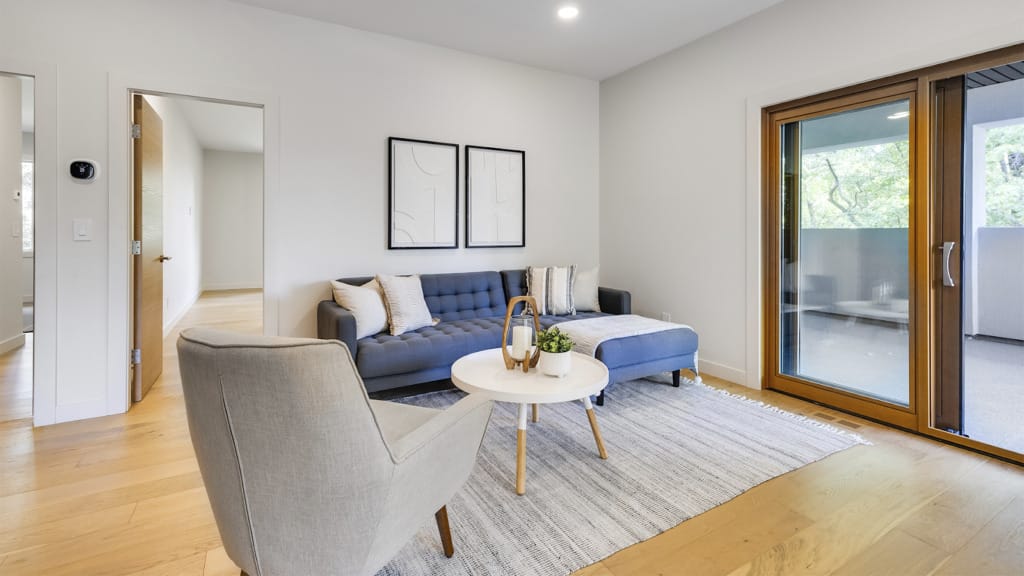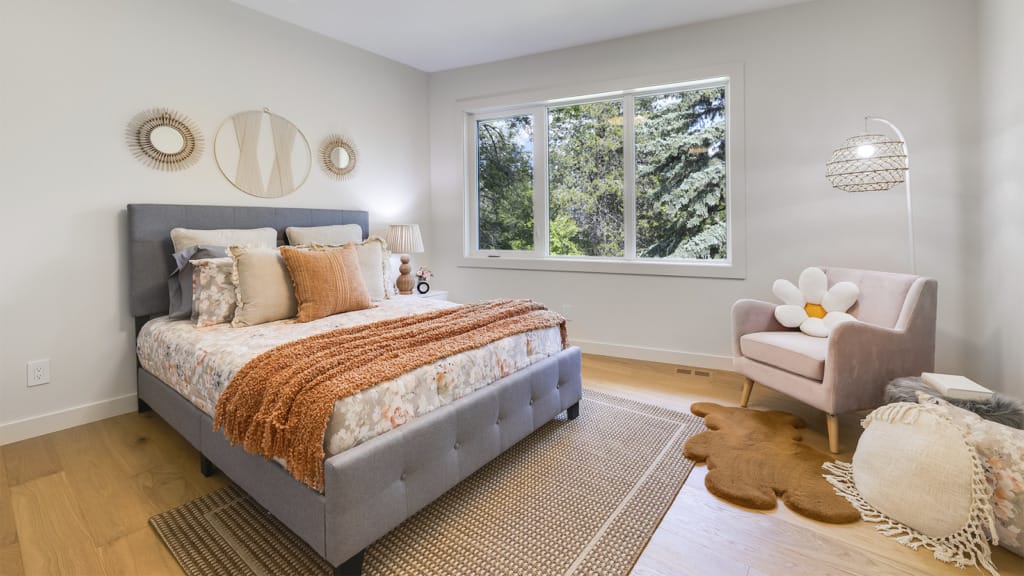Staging a chic downtown condo and a spacious suburban home both aim to wow buyers, but the strategies can differ dramatically.
Think about it: the lifestyle of a city loft dweller is not the same as a family in a cul-de-sac. Buyers in each market have unique expectations and preferences. To make the most of your staging, it’s important to tailor your approach to the type of property.
Here, we’ll explore the key staging differences between an urban condo and a suburban house, from maximizing small spaces to emphasizing family-friendly comfort.

Maximizing Space in Urban Condos vs. Emphasizing Openness in Houses
Space (and the perception of space) is a critical factor in staging any home, but urban condos and suburban houses tackle this challenge from opposite angles.
In a downtown condo, often smaller. The goal is to make every square foot count. Urban buyers typically expect clever use of limited space. This means embracing multi-functional furniture and smart layouts.
For example, you might stage a condo living area with a sleek sofa that doubles as a guest bed, a drop-leaf dining table that can expand for entertaining, and stylish ottomans that provide both seating and hidden storage. Using vertical space is another trick: tall bookcases or wall-mounted shelves draw the eye upward and free up floor area. Even a well-placed mirror can create an illusion of a bigger, brighter room by reflecting light and views. For more ideas on creating a spacious feel, check out Creative Redesign Ideas for Small Spaces.
In a suburban house, by contrast, space is a selling point to be highlighted, not created. Suburban homes generally offer more square footage, so staging focuses on making rooms feel open, flowing, and functional. You’ll want to arrange furniture in each room to showcase its generous size while still feeling cozy.
For instance, in a large living room, you might create two conversation areas rather than one cavernous seating arrangement, to suggest multiple uses of the space. Ensure pathways are clear and the layout invites movement; buyers should sense the easy flow of a house that could accommodate their family and guests comfortably. High-demand suburban features like a spacious kitchen or a bonus room should be staged to demonstrate openness and versatility. Even in bigger homes, remember to declutter and remove any oversized furniture.
In short, condos must appear as roomy as possible, while houses should emphasize their abundant space yet maintain a warm layout.
If you’re working on a larger property, you might find these Proven Home Staging Strategies to Sell Your House Quickly especially useful.
Style and Design: Modern Minimalism vs. Cozy Tradition
Another major staging difference lies in the design style that appeals to urban condo buyers versus suburban house buyers. Downtown condos often attract young professionals, couples, or downsizers who lean toward a modern, minimalist aesthetic. In staging an urban condo, sleek and contemporary décor usually wins.
Think clean lines, simple color palettes, and a “less is more” approach to accessories. You might use a neutral palette of whites, grays, or cool tones to create a sophisticated backdrop that amplifies light. Bold art or trendy accents can work in a condo, but use them sparingly as focal points. The idea is to convey a stylish, turnkey lifestyle – city buyers often value a space that feels updated and chic, like a stylish hotel or an upscale catalog spread.
By contrast, suburban homes traditionally benefit from a cozier, more traditional style to appeal to family-oriented buyers. That might mean warmer color schemes (soft beiges, warm blues or greens), classic furniture pieces, and touches of comfort like plush throw pillows or a reading nook with a comfy armchair. The exterior architecture often guides the interior staging: for example, a colonial in the suburbs may be best staged with some classic elements to match its character, whereas a new-build in a suburban development might handle a more transitional style. For more inspiration, you can explore Living Room Furniture Layout Ideas or Top 10 Trendy Interior Design Ideas.
The key is to make a house feel like a home – inviting, lived-in (but not cluttered), and ready for a family to settle in. Cozy doesn’t mean cluttered, of course. You’ll still want to neutralize and depersonalize to some extent, but you can incorporate a bit more warmth through textures and furnishings. Traditional design elements like a wood dining table, a patterned rug, or built-in bookshelves with a few well-chosen decor pieces can signal the comfort and stability that many suburban buyers seek
It’s worth noting that these aren’t hard rules; some city condos might be staged with a touch of warmth to soften a stark modern box, and some suburban homes (especially high-end ones) might go very sleek and modern. However, understanding your target buyer demographic is crucial. Urban buyers tend to prioritize a “sleek and new” vibe, valuing finishes like concrete or stainless steel and smart-home features.
Highlighting Lifestyle: City Convenience vs. Family-Friendly Features
When staging, think beyond the walls of the property – consider the lifestyle selling points of each location. A downtown condo’s staging can subtly highlight urban conveniences, whereas a suburban house should play up family-friendly features and outdoor living.
For a downtown condo, you want buyers to feel the cosmopolitan lifestyle. While you can’t change the location, you can stage to complement it. If there’s a great view of the city skyline, arrange furniture to draw attention to the windows and keep window treatments minimal to showcase that view. Create a little coffee station in the kitchen or a bar cart in the living area to evoke the idea of chic city entertaining. If the condo is near cultural amenities (theaters, cafes, transit), you might leave out a stylish magazine or coffee table book about city living, or even a subway map framed on a wall as art, small nods that say “this is the hip urban pad you’ve been looking for.” Additionally, storage solutions should be emphasized in condos. Urban buyers know storage is at a premium, so consider staging an organized closet with a closet system or a wall bed that folds up to show a multi-use space.
In a suburban house, lifestyle staging is about family, community, and comfort. If there’s a backyard, stage it as an extension of living space: set up a patio table and some string lights to suggest enjoyable summer BBQs, or place a couple of Adirondack chairs under a tree to show a tranquil retreat. A playset or sandbox (if in good shape) can actually be an asset, as long as the yard is tidy, it signals a family-friendly environment. Inside, if you have a mudroom or foyer, consider cubbies or hooks with a few cute backpacks hanging, to demonstrate the home’s functionality for an active family. Highlight proximity to schools and parks by perhaps pinning a community brochure or school newsletter on a bulletin board staged in the kitchen command center (subtly). The staging should whisper that “this is a place to put down roots.” Emphasize features like a cozy fireplace, a big dining table for family dinners, or a finished basement rec room set up with a game console or craft table, if applicable. All these cues help a suburban buyer envision their comfortable, family-oriented life in the home
Another lifestyle difference: privacy and tranquility. City condos can be staged to feel like a private retreat from the bustling city, using plush fabrics and maybe a white noise machine subtly during showings to mask street sounds, creating a serene interior despite the urban setting. In the suburbs, privacy is often abundant, so staging might involve showcasing a fenced yard or a cozy reading corner by a window, emphasizing the peaceful neighborhood vibe. For tips on making spaces warm and inviting, read Winter Staging Tips for a Cozy Home.
Outdoor Spaces: Balcony vs. Backyard
Outdoor areas are a prime example of staging differences. A downtown condo might have a small balcony or terrace, while a suburban house likely boasts a yard or garden. Staging each requires a different touch.
For a condo balcony (even if tiny), show it can be an asset, not an afterthought. Use space-saving furniture like a petite café table with two chairs or a built-in bench with cushions. Add a few potted plants or a vertical garden feature to bring in greenery without taking up floor space. If the view is attractive, keep the railings clear and maybe place a pair of wine glasses on the table to paint the picture of relaxing evenings above the city. Even a little balcony can feel like an outdoor oasis if staged right – a rug, a lantern, and some wall planters can transform a drab slab of concrete into a bonus “room.” The key is to maximize limited outdoor space just as you do indoors, by being creative and keeping scale in mind.
In a suburban backyard, the focus is on demonstrating the yard’s function and appeal. Big yards can actually overwhelm buyers if empty, so divide the space into zones that suggest purposeful use. For example, on a deck or patio, arrange outdoor lounge furniture or a dining set to show where one could entertain. On the lawn, if there’s space, you could place a couple of lawn chairs around a fire pit or set up a badminton net – simple cues that say “fun happens here.” Landscaping matters too: trim the bushes, mow the lawn, maybe plant some colorful flowers for curb appeal. Suburban buyers often dream of letting kids or pets play outside, so ensure the yard looks safe and inviting. A play area (like a swing set) should be neat and in good repair, staged with maybe a bench or picnic table nearby so parents imagine themselves watching the kids play. Privacy features like a fence or hedges can be highlighted rather than hidden, since many suburban buyers appreciate the sense of personal space
Practical Logistics and Staging Focus
Finally, consider some practical differences: what rooms and features to prioritize in each case. A suburban house usually has more rooms – possibly multiple bedrooms, living and family rooms, etc. It’s wise to stage as many of the main areas as possible so that none feel cold or confusing. Focus on key rooms like the living room, kitchen, master bedroom, and any special feature room (e.g., an office or den) because those make the biggest impact on buyers walking through. Each room in a house can be given a clear purpose: if you have a small extra room, stage it as a home office or a nursery rather than leaving it empty, since suburban buyers will want to see how that space can be used.
In a condo, you have fewer rooms, but often an open concept. The challenge is to delineate areas (living, dining, office nook) without walls. Use rugs or furniture placement to define “zones” in a studio or one-bedroom condo. Because you can’t stage an entire multi-room experience, make sure the primary living area in a condo really shines in photos; that’s what will lure buyers in. The bedroom in a condo, even if small, should be staged to fit the largest bed that makes sense (if you can showcase a queen or king bed fitting comfortably, it signals ample space – as one stager notes, showing a king bed in a condo master can make the unit appear more luxurious and attract higher-end buyers. Also, address functionality: for instance, if the condo lacks an obvious home office, consider staging a tiny desk in a corner or a fold-down workspace to tap into the needs of remote workers.
Logistics behind staging also differ. While buyers won’t see this directly, it’s useful to know: staging a condo may involve coordinating with building management (for use of elevators, parking for movers, etc.), which can add complexity. For the homeowner, this means planning staging (or any pre-sale fix-ups) with a little more lead time. On the flip side, a suburban house might require more furniture and décor to fill it out, potentially increasing staging costs if you rent furniture. However, in an occupied suburban home, you might be able to work with more of the owner’s existing furniture, whereas condo owners (often younger or single) might have less to start with and need supplemental pieces. As a result, budget allocation could differ: in a condo, splurging on a few space-saving, stylish pieces (or rentals) to make it stand out could be worth it, while in a house, you might invest more in curb appeal enhancements and a few key room updates (like fresh paint or modern light fixtures in the kitchen). Ultimately, the staging of any property, city condo, or suburban house, should answer the buyers’ unspoken question: “Will this home suit my lifestyle?” For a condo buyer, emphasize convenience, style, and smart use of space, painting the picture of an easy, exciting urban life. For a house buyer, highlight comfort, space, and family living, helping them envision growing into the home for years to come. By recognizing these differences and adjusting your staging strategy accordingly, you’ll increase the appeal of your property to the right audience and improve your chances of a quick, top-dollar sale. If you’re weighing whether to handle staging yourself or hire a pro, this guide on Professional Staging vs. DIY can help you decide what’s best for your property and budget.


